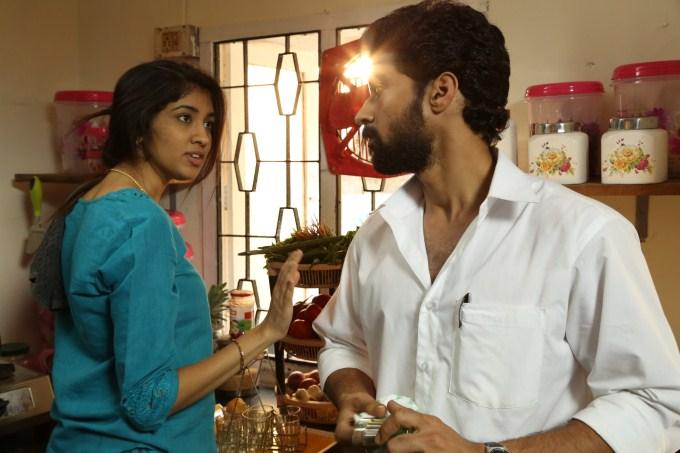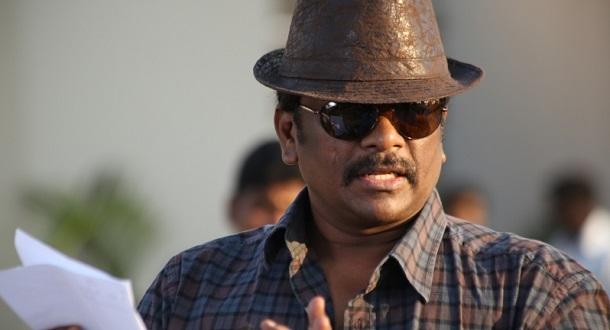Kathai Thiraikathai Vasanam Iyakkam: Parthiban’s Idea of Tamil Cinema
R. Parthiban’s education in cinema began in the single screens of Madras, present-day Chennai, where he would often go for multiple shows of strange and obscure films in various languages. In an eye-opening interview with Baradwaj Rangan, Parthiban spoke of some of these films, their unique qualities and how they nonetheless flopped at the box office. Parthiban also outlined his desire to “cut his teeth” in cinema by assisting either the auteur-actor K. Bhagyaraj, known for his utterly distinct style and great comedic instincts, or K. Viswanath, who had the unique ability to imbue blockbusters with social messages. Parthiban eventually landed under Bhagyaraj’s guidance, learning the rather tricky art of being an auteur-actor, the technical aspects of filmmaking, and the importance of dialogue, a critical feature of Tamil cinema.

L: Parthiban with his cinematic mentor K. Bhagyaraj. Courtesy of Akash.
R: Parthiban with Rajinikanth. Courtesy of Ravi Varma V.
Parthiban made quite a splash in 1989 with his directorial debut Pudhiya Paadhai (New Path), telling the story of a rapist who is reformed by his victim, a theme that has not withstood the test of time. While Parthiban emerged as a distinct voice in cinema, he also worked within certain frameworks popular in Tamil cinema, be it tropes about orphans, the redemption arc of a protagonist and melodrama, to name a few. Tamil cinema works within familiar and set expectations, where audiences visit the theatre to be guided by well-acquainted guard rails. In simple terms, one goes to see a Rajinikanth film by a new or upcoming director to see how the director has managed to make a “Rajini film”, with all its attendant tropes, and not the other way around. In this sense, Tamil cinema is caught in a metatextual loop, with films referencing films that reference other films.
Parthiban at a promotional event. Courtesy of Bala.
Recalling Sheldon Pollock’s remarks in his essay In Praise of Poets: On the History and Function of the Kaviprasama, pioneers who worked within established frameworks of praise-poetry eventually transcended them to dictate a new form, one worthy of the canon. Tamil films often operate under the same logic dictated by the established canon. It is for this reason that even so-called new-wave classics like Subramaniapuram (2008), directed by Sasikumar, are drenched in references to films of the past. Parthiban has never forsaken his audience while nudging them along an idiosyncratic career path, one that even led to a national award for Housefull (1999), a film without a working script.

A scene from Kathai Thirakathai Vasanam Iyakkam. Courtesy of WikiCommons media.
Parthiban is at the peak of his metatextual powers in Kathai Thiraikathai Vasanam Iyakkam (2014), famously marketed as a film without a plot. The film revolves around the director Thamizh (played by Santhosh Pratap). Parthiban channels himself through Seenu, the character essayed by Thambi Ramaiah, who aspires to be a director but lands up as a hanger on. Seenu is a man with nowhere to go but armed with a cinematic vocabulary that finds room for eclectic movies of varying popularity like Anbe Vaa (1966), Namma Veettu Dheivam (1970), Vellikizhamai Viratham (1974), and Aval Appadithan (1978). Parthiban’s goals are not too ambitious in this movie. As Rangan notes, “To aim for posterity or to live the moment? Parthiban blithely and quite literally opts for the latter. Thamizh decides that his film will not have a story, thus allowing Parthiban to dispense with a conventional plot where each scene delves into the next one; instead, he just lives from moment to moment. This is the logical culmination from the beginning of the film, with seemingly unrelated sequences urging the viewer to lend the scenes the benefit of the doubt. Is the bar scene there because today’s films are inconceivable without a bar scene? In other words, is Parthiban selling out and sticking to the conventions with an eye on the box office, or is the scene there just because? Are the rhyming dialogues simply the result of Parthiban’s love for wordplay, or are they satirizing such lines from Tamil cinema? The nods to the thaali sentiment (a matrimonial necklace that Tamil cinema uses as a visual signifier for patriarchal values) are easier to recognize – they’re just wicked nudges in the rib.”

Parthiban on the set of Kathai Thiraikathai Vasanam Iyakkam. Courtesy of moviegalleri.net.
Kathai Thiraikathai, for the most part, is borne along rhythms that are slightly off-kilter. It has the snap-like rhythm of a student film as well as the awkward, self-conscious performances. Parthiban’s appetite for risk, offset by his more lucrative acting cameos, has kept him afloat in a rather merciless industry, with shelves of unmade scripts often lying in cold storage. One can only wonder, given the chance, how much more he could have shifted the needle of Tamil cinema. Till then, Parthiban remains one of the industry’s most critical insider observers.
To read more about popular cinema and its histories, click here and here.




